Artists: Marina Alexeeva, Lyudmila Belova, Petr Belyi, Katya Bochavar, Elena Gubanova and Ivan Govorkov, Alexey Grachev, Alexander Dashevsky, Alexandra Dementieva, Leta & Vladislav Dobrovolsky, Anna Frants, Sergey Komarov, Marina Koldobskaya, Vladimir Kozin, Vitaly Pushnitsky, Petr Shvetsov, Alexander Shishkin-Hokusai, Alexander Terebenin
Marina Alexeeva, Life and Adventures of White and Black, Episode 3
Video installation, 2014
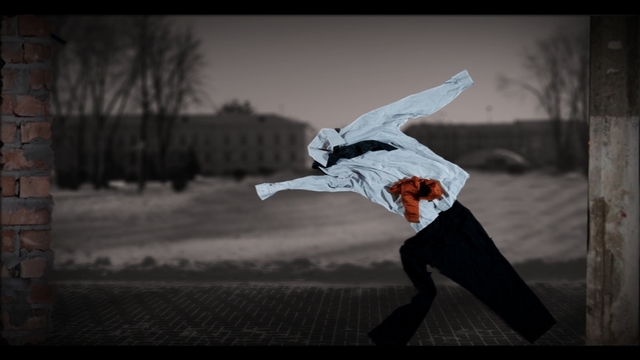
Depicting an epic struggle of black versus white in which headless, faceless pugilists oppose one another on the basis of costume alone, (black versus white), Alexeeva calls into question our reliance on superficial determiners of difference and the wars we wage between and amongst ourselves.
Ludmila Belova, Archive
Installation, 2002—2014
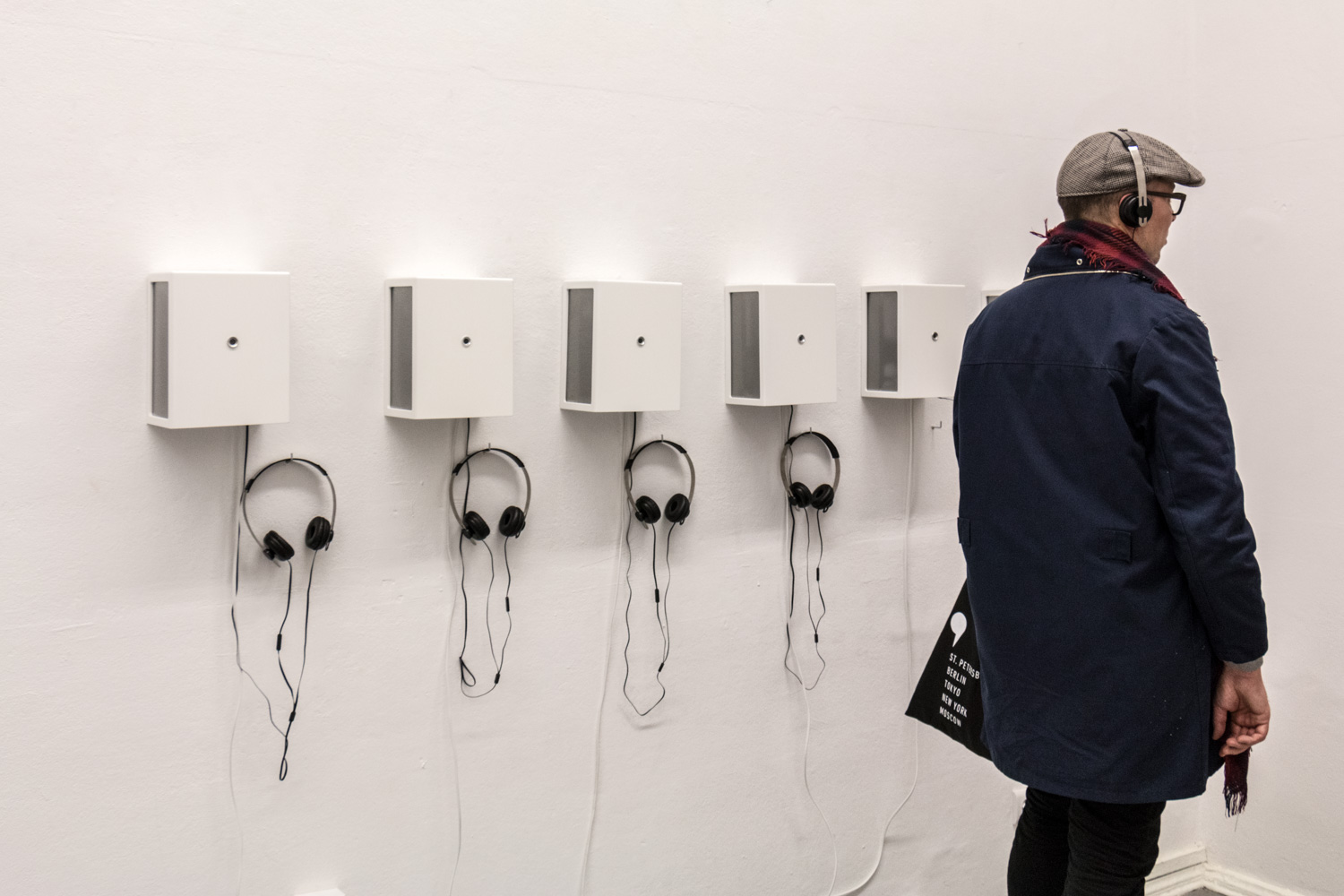
The author placed photographs found in the archive of a real-estate agency into the objects-boxes equipped with peep holes and a media player that provides an opportunity to hear typical sounds of the entranceways: footsteps, knocking on doors, fragments of conversation, sounds of fireworks coming from the street, singing around the festive table from an apartment next door. By placing the image into the box with a space-curving peep hole, into which just one person could peak at a time, and by providing a sound accompaniment, which is, once again, meant for just one person at a time, Lyudmila Belova endowed the banal photograph, furthermore, the very staircase, the space of an entranceway with a symbolic meaning. By peaking into the peep hole of an individual box, the viewer gets into a dream space. Where staircases are not real, but symbolic; the climbing up, ascent promise a new knowledge; the submerging into the depth — a cognition of one’s own internal experience. An open door attracts not by virtue of simple curiosity, but it entices as a deck of tarot cards, slightly lifting up the veil over future. The sound that accompanies the curved space, which became three-dimensional thanks to the lens of a peep hole, does not bring the viewer back to his reality, but rather makes the immersion into a different reality even more complete. —Elena Neverdovskaya
http://www.ludmilabelova.com/
Ludmila Belova, Soon It Will Be
Installation, 2003
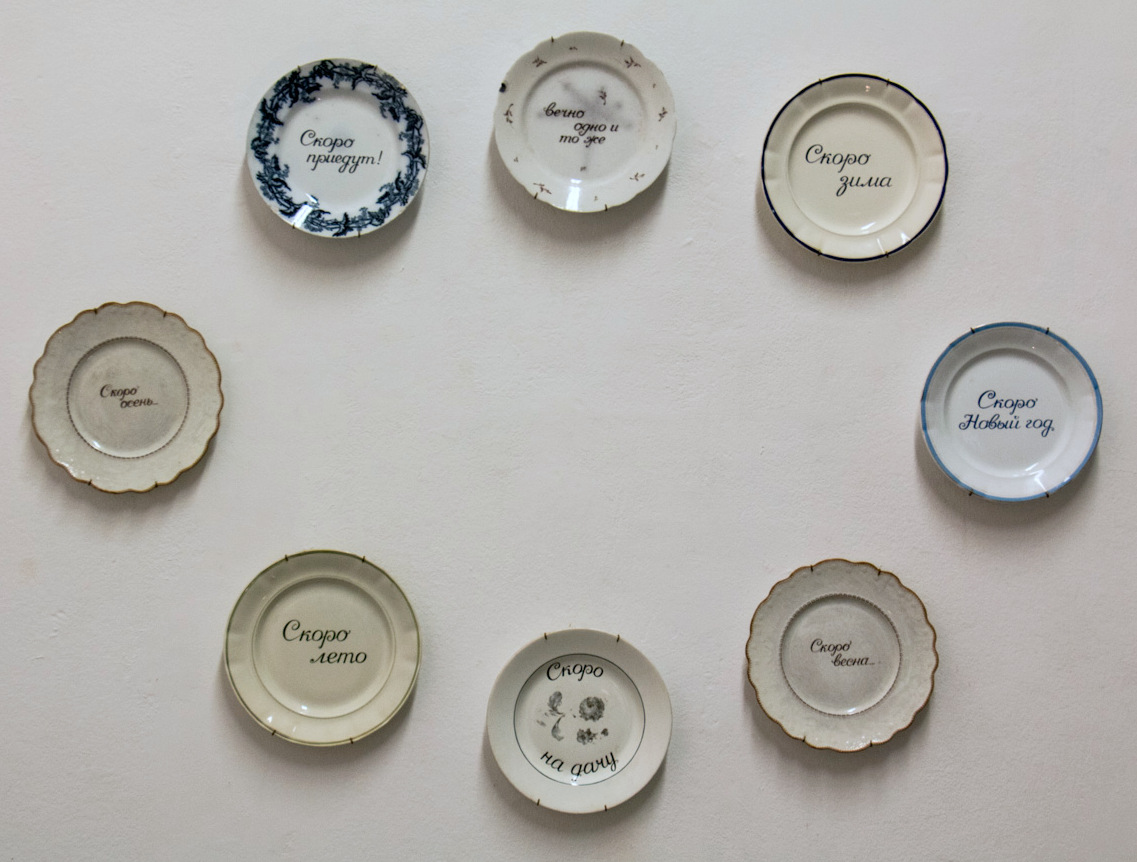
Calligraphic inscriptions drawn onto the cracked glaze of the surface, «soon it will be summer,» «soon it will be spring,» «soon it will be time to go to the country house,» «soon it will be lunch,» reflect the consistency of our expectations. Here the word «soon» invariably appeals to a future, in which time is measured not in hours, but in hopes, rendering meaningless the fact that everything promised has already come to pass and it will certainly come to pass again, reframing time within the cyclical realities of human desire.
http://www.ludmilabelova.com/
Peter Belyi, Dream and Ball
Installation, 2014
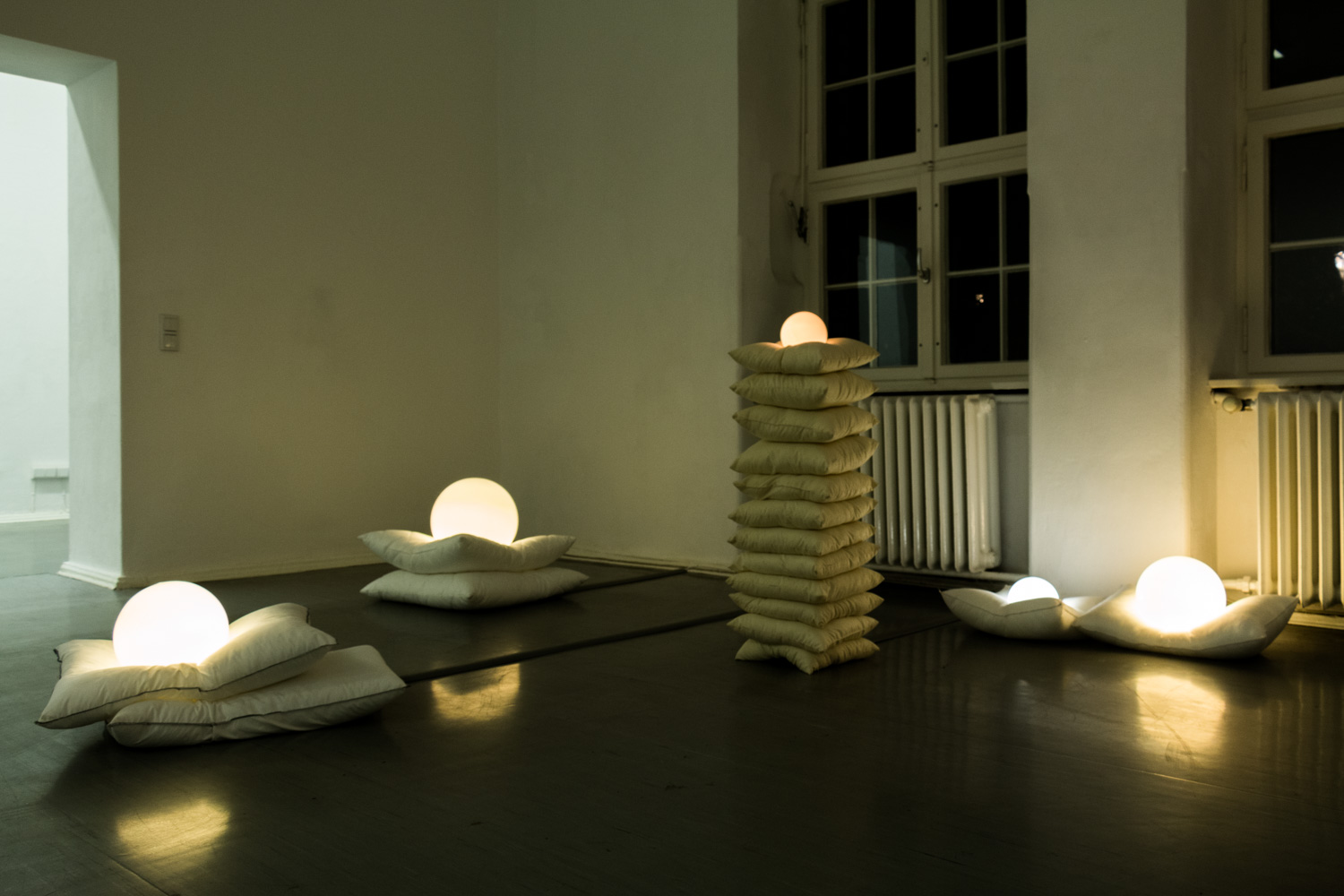
The monotonous light flowing out of the ball is the dream of a person with clear conscience. The quiet, deep pink glow is the dream of a child; the nervous, quivering light is the dream of a criminal; the cold light is the president’s dream; the greenish glow is that of a homemaker. The ball rests on a pillow; it is asleep.
http://peterbelyi.com/installations
Katya Bochavar, Frozen Life
Installation, 2014
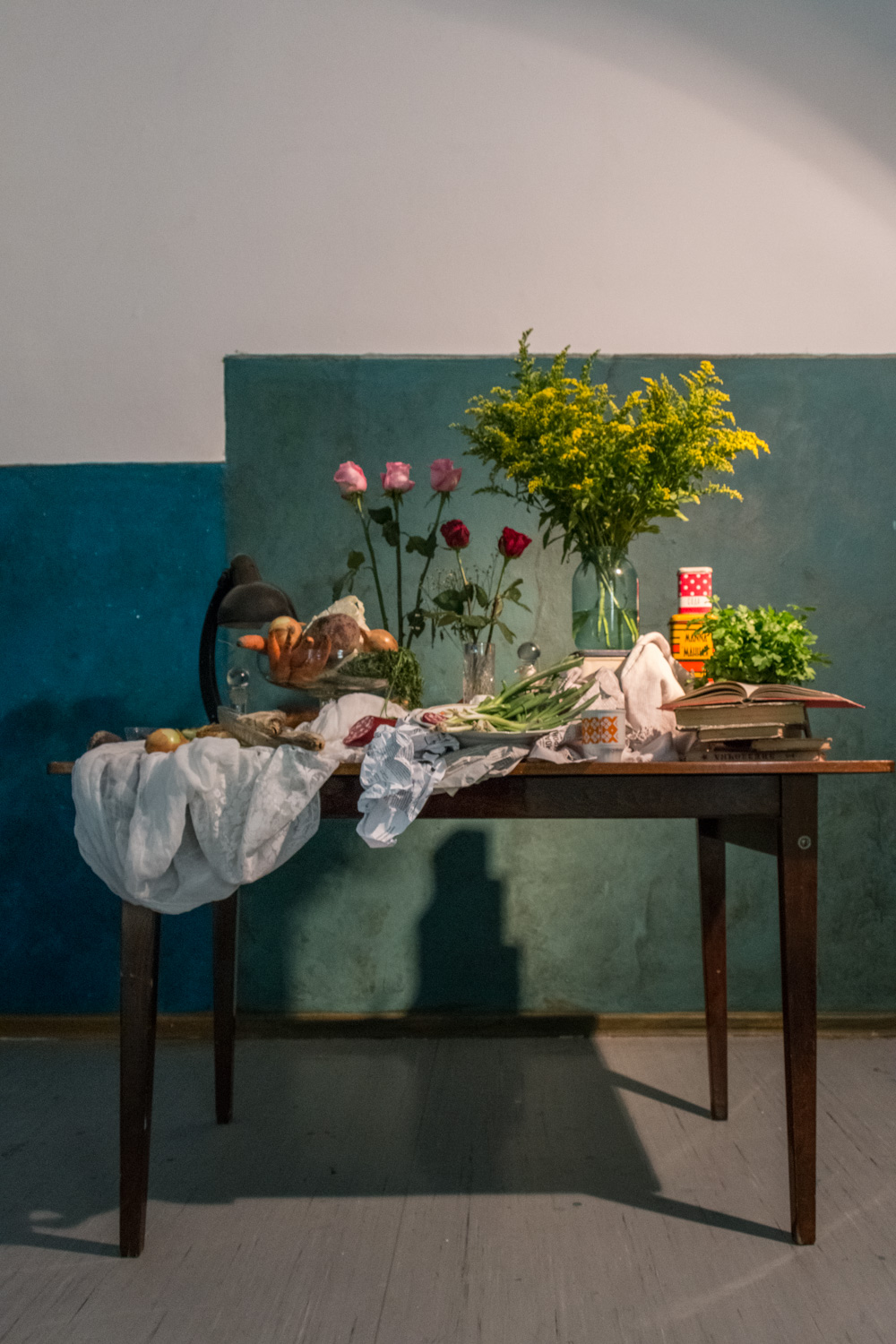
I am an artist; I studied to be an artist. For six years, they taught us to draw flowers and to paint still-lives. The most important lesson that I learned from those studies is that the portrayal of realty was rather indirectly related to the reality as such. The frozen life can be expressive and similar to the real one or even more expressive and more similar to the reality than the reality itself. And yet, this is not so much a portrait of the object that we see as a portrait of time, a portrait of mood, a portrait of the artist… I saw a group portrait of the several generations of Soviet citizens in still-lives of the Soviet Grand Style. The objects amassed in them are the common memory of those who lived in the Soviet and Post-Soviet times. The type production, spreading form the Black Sea to Kamchatka, constituted the everyday life of all layers of the population – from full professors to street cleaners. The material memory of those years gradually disappears, together with chipped teapots and cardboard valises that fell into disuse. Such dear and familiar vases and teacups are still sitting in the china cupboard of your neighbor old lady, but they catch one’s eyes increasingly seldom. Using them for the reconstruction of still-lives-memorials, I reflect with a sweet sorrow on the transience of it all. —Katya Bochavar
Elena Gubanova and Ivan Govorkov, Anthill
Installation, 2014
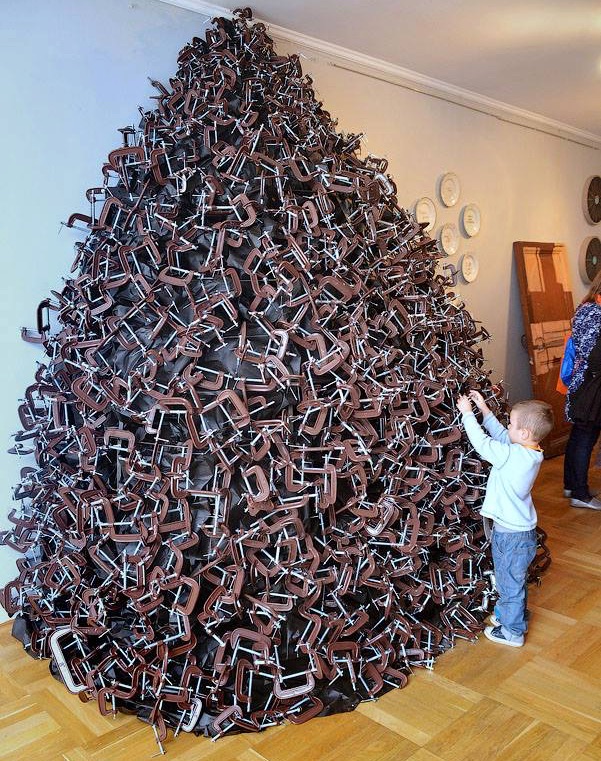
Photo Vladimir Mikhaylutsa
Elena Gubanova and Ivan Govorkov, Eclipse
Installation, 2014
«…All men, lions, eagles, and quails, horned stags, geese, spiders, silent fish that inhabit the waves, starfish from the sea, and creatures invisible to the eye—in one word, all the lives, all the lives, all the lives, completing the dreary round imposed upon them, have died out at last. Thousands of centuries have passed since the earth last bore a living creature on her breast, and the unhappy moon now lights her lamp in vain. No longer are the cries of storks heard in the meadows, or the drone of beetles in the groves of limes. All is cold, cold, cold. All is void, void, void…» —A. P. Chekov, «Seagull»
http://elenagubanova.com
Alexey Grachev, Sense of Proportion
Installation, 2014
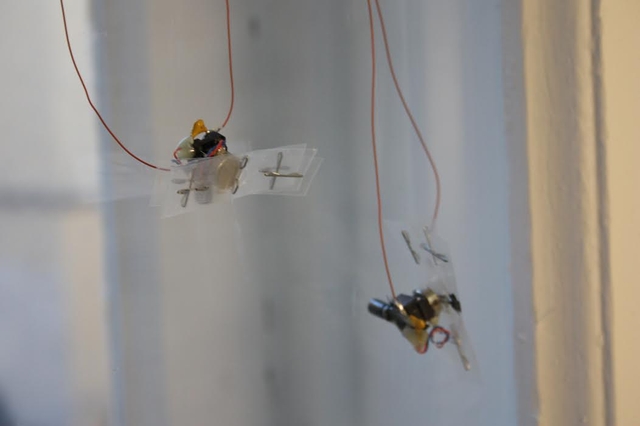
«History acquaints us with examples of the notion
That sense of humor is of use, as is sense of proportion.»
—Renata Muha
Alexander Dashevsky, Partial Loss
Installation, 2014
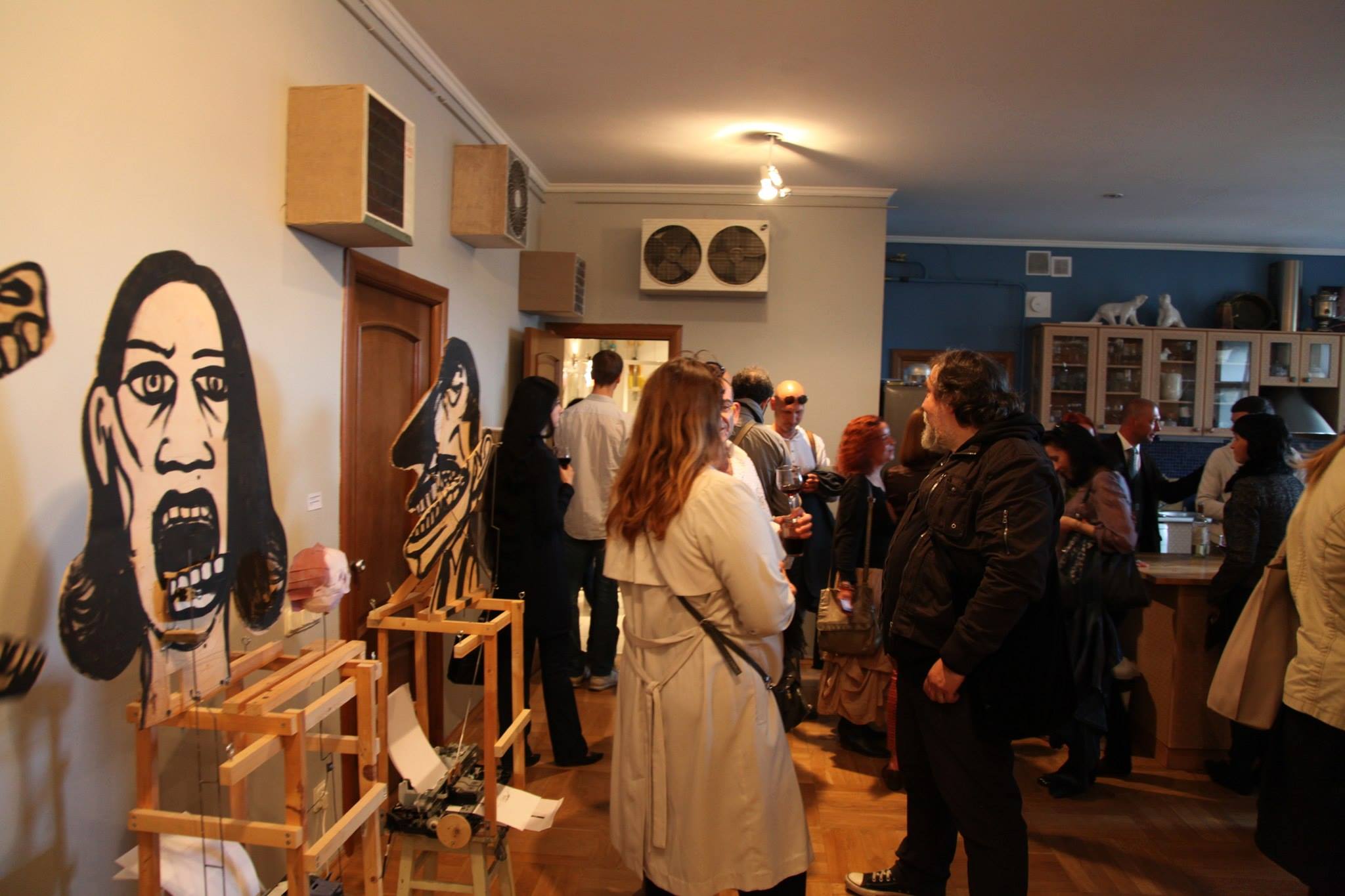
Alexander Dashevsky, Mortgage Languor
Oil on canvas, 2014
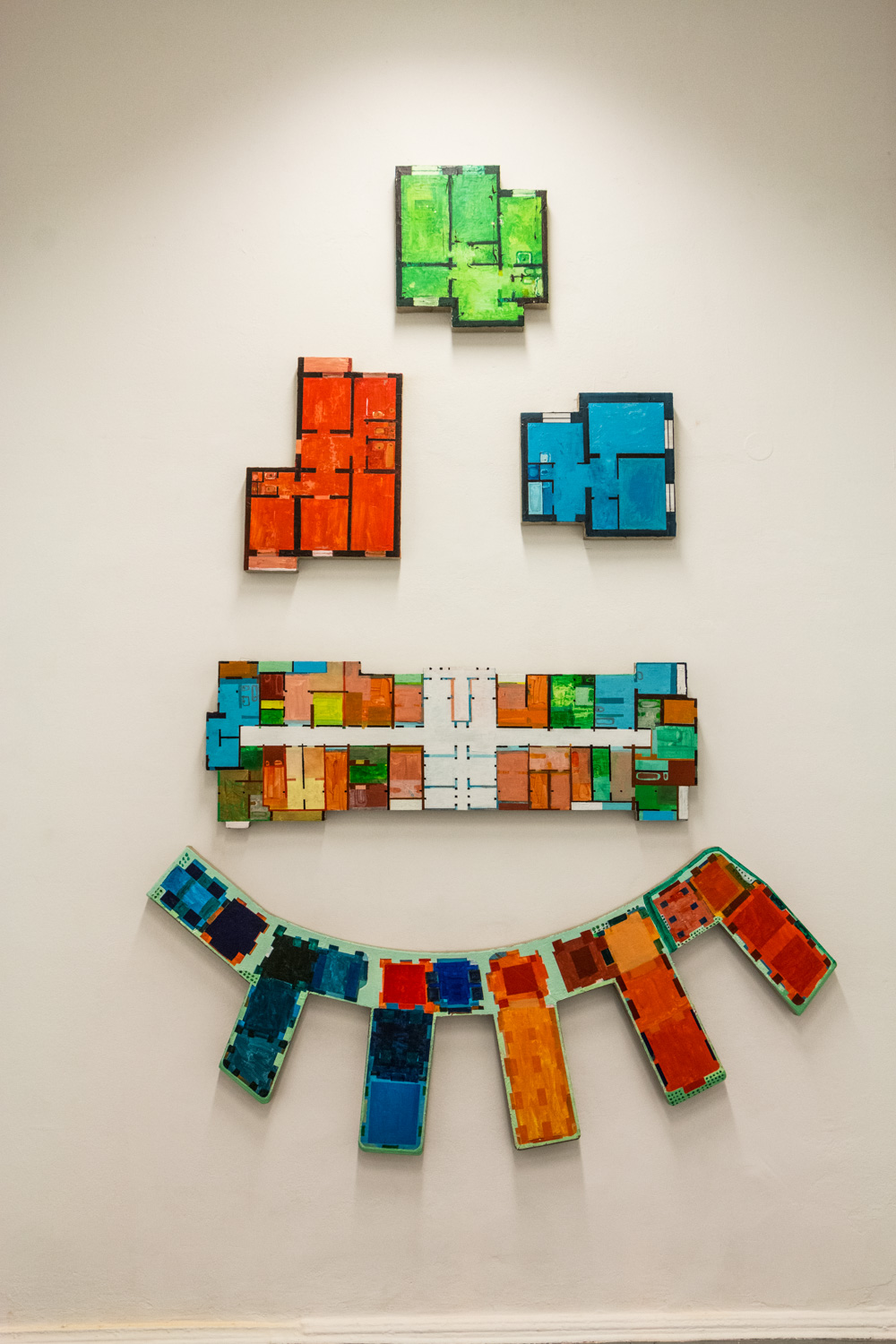
Development and real estate are exact spheres measured in investments, square meters, adjustments, liquidity, profitability, and risks. And yet, the imperative to acquire property stems not only from mathematical calculations of financial acuity but also from ineranlized goals and imperatives constructed in the realms of philosophy and ideation. In both worlds, the purchase of a home is a watershed moment — a point of maximum exertion of material and spiritual strengths. And yet, home ownership is not a secure transaction, phsycologically, financially or philosophically, and at some point the threads woven so carefully together to realize this disparate goal begin to unravel. Dashevsky’s work takes root in the space between ideology and reality, between home ownership and homelessness, between security and the great unknown, problematizing both the concept of home ownership and the psycho-social imperatives made manifest in this oh-so-specific cycle of acquisition dissolution.
Alexandra Dementieva, Mirror’s Memory
Installation, 2003—2014
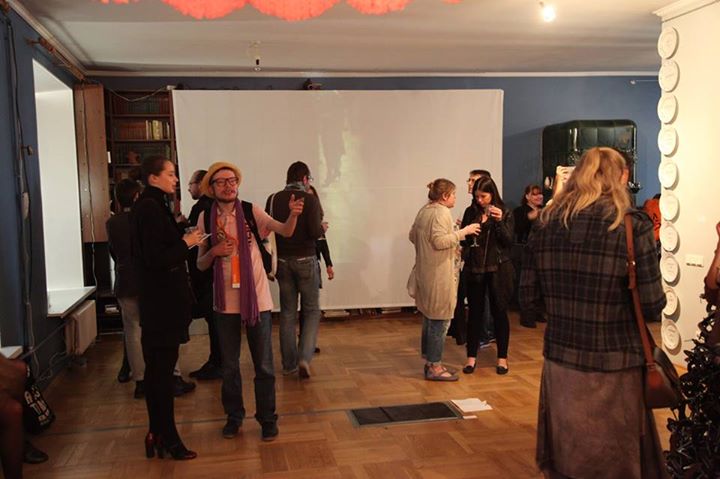
This installation reacts to visitor presence on the interactive carpet by superimposing various images, scenes and sounds generated in a random manner. The exhibition behavior evolves during the duration of the show; is modifies according to the database of all the people who visited the exposition.
http://www.alexdementieva.org/
Anna Frants, On the Lookout
Installation, 2014
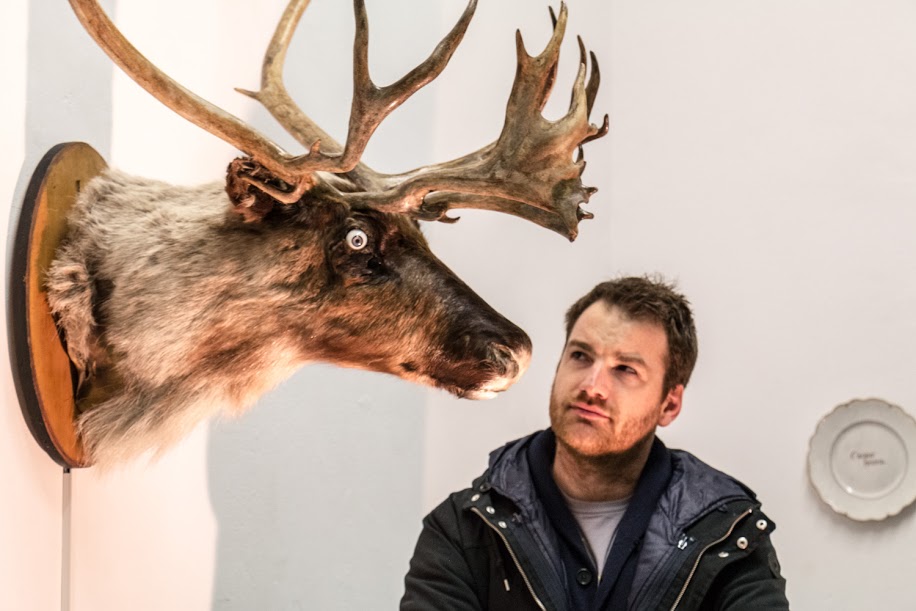
“If paranoia transforms into persecutory delusion or persecutory, one talks about an isolated delusional disorder. Delusional Disorder is a mental illness that is characterized by the presence of a well-systematized domineering delusion, but, unlike schizophrenia, devoid of quirkiness.” —Wikipedia
Legend has it that the expression “even walls have ears” can be traced back to Dionysius I, the 5th Century BC tyrant of Syracuse who was the first to come up an ingenious method of eavesdropping before succumbing to the paranoia surveillance inevitably engenders. Could it be that paranoia starts when “on the lookout” and “apprehension” take up residence in the same body? Where does madness begin and sanity end? On the Lookout takes up these questions, reflecting on the nature of surveillance, the social context of psychology and the organization of the human soul.
Anna Frants, Socks Snapper
Installation, 2013
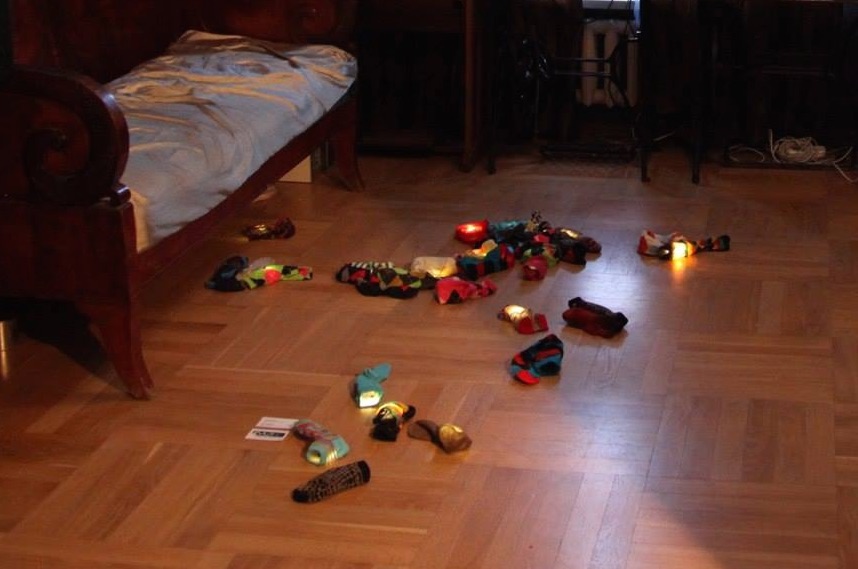
This work commemorates deceased pets. Everybody knows pets love to steal things. We can see a heap of socks of various colors on the floor, and every sock is odd – its pair may be being chewed on under the sofa. The socks are glowing from inside, one after another…
http://annafrants.net/
Sergey Komarov, Leta & Vladislav Dobrovolsky, Kitchen
Installation, 2014
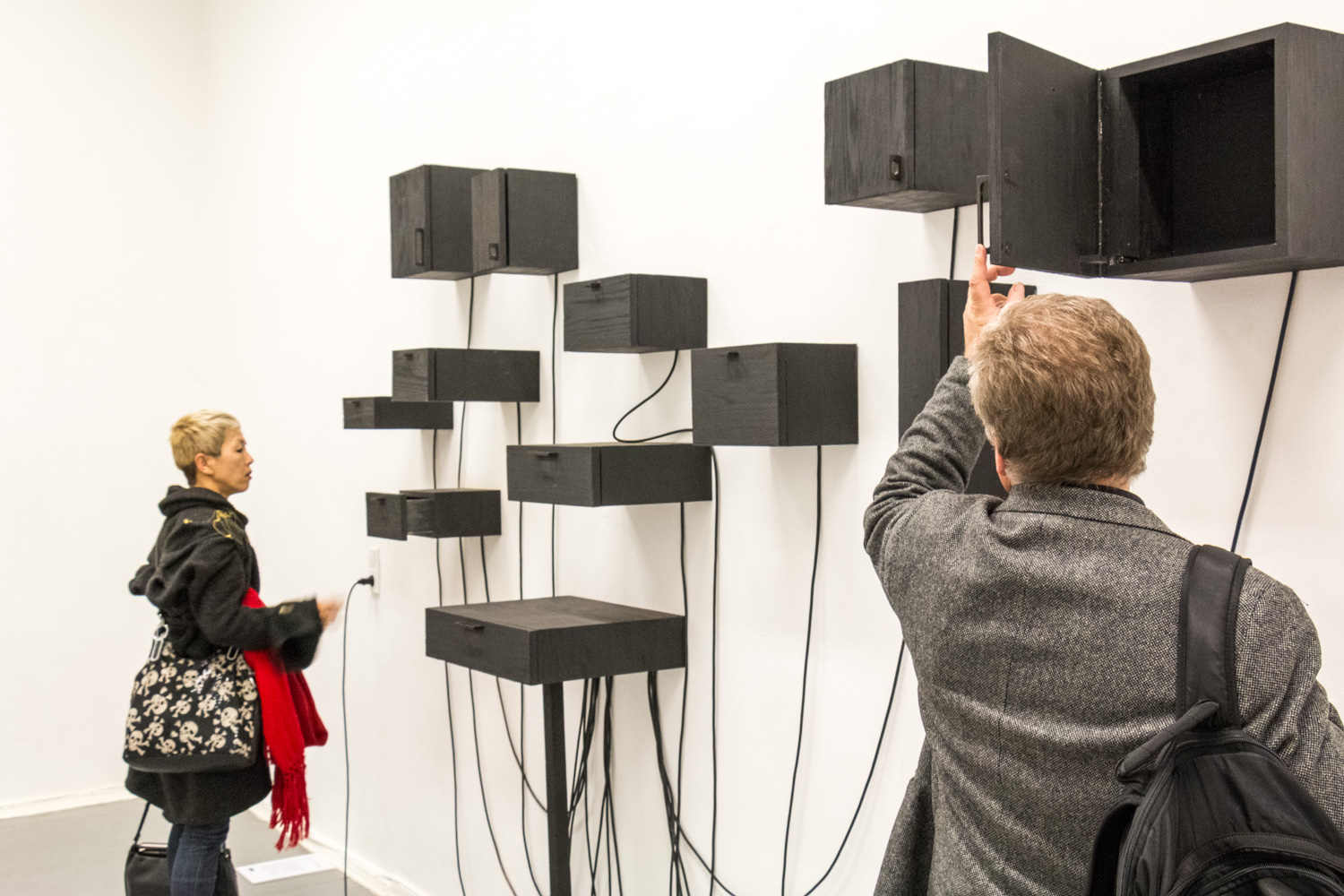
Kitchen consists of 12 black drawers composed to resemble kitchen cabinets, and containing within a unique audio file that plays for the visitor each time the cabinet’s door is opened. The viewer, manipulating the cabinets by opening the each in turn, can act as composer, creating a unique opus, through the combination of select sound files in turn. Each individual has the opportunity to craft a personal soundscape that evokes not only the desires and preferences of the viewer, but also the unique moment of time spent with Kitchen itself.
Marina Koldobskaya, Cat & Rat
Installation, 2014
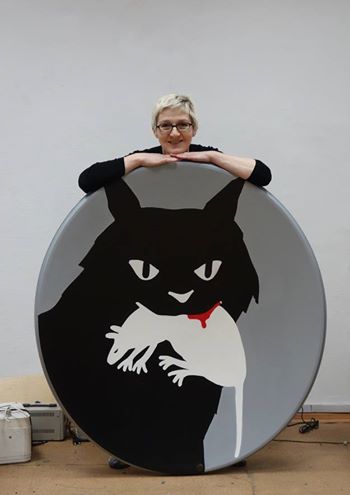
We live among gadgets, devices and balls of tangles wire. Our ears are filled with audio advertisement, phone warbles, squeaks of action games, crackles of shooters and radio call signs. There are more screens than landscapes, more avatars than faces, more chats than conversations. We push buttons more often than we shake hands; we receive offers of friendship from strangers and love missives from robots. The digital Fata Morgana corrodes reality— we are asked every day to prove that we are no robots ourselves. Alive to the twin legacies of Dada and Pop Art, Koldobskaya’s work takes hold of the satellite dish as an object of symbolic and formal significance. By positioning the dish in opposition to animality and all that is organic in this life, Koldobskaya uses humor, wit and wisdom to engage with the great question of what does in fact separate us from the ones and zeros that make up our digital life, our online personhood, our robot avatars.
http://marinakoldobskaya.com/
Vladimir Kozin, Baby Bootee
Installation, 2009
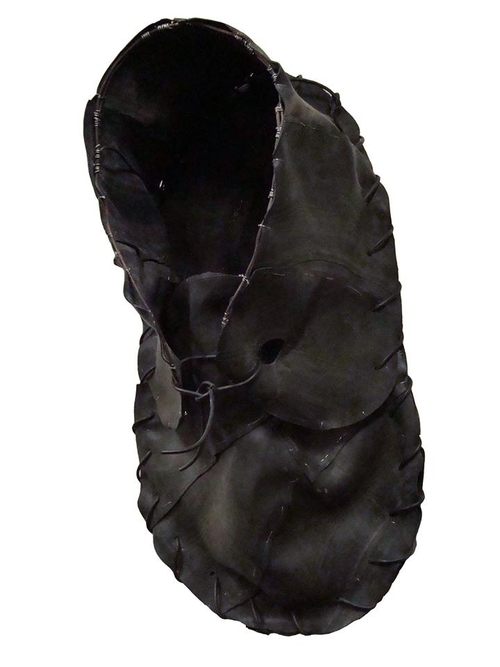
Baby Bootee stands alone as one of twelve monumental objects manufactured from automobile tires for the Timeless Values series, 2009—2010. As a series, the 12 sculptural objects together symbolize the important stages of human life, from womb to tomb, while Baby Bootee individually represents childhood in fractured and deconstructed isolation. Exploring both individual human significance and the relentless passage of time, Kozin breaks life and art down to its component parts allowing for a closer reexamination of both the moments and the materials that make us truly human.
Vitaly Pushnitsky, Sunlight
Installation, 2014
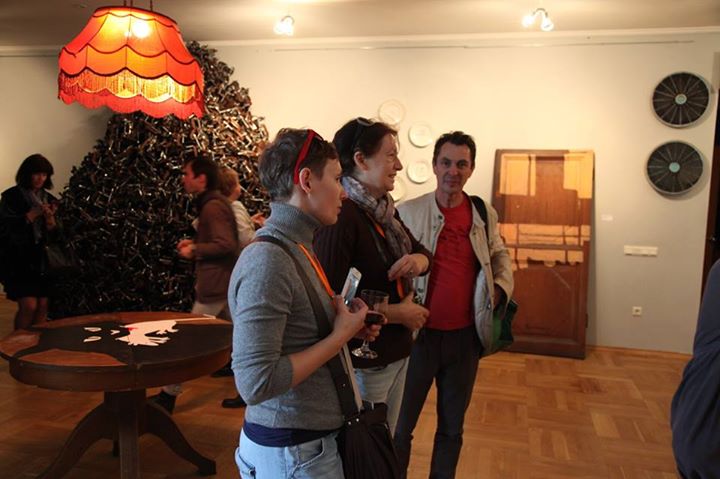
Vitaly Pushnitsky, Rainbow Bridge
Installation, 2014
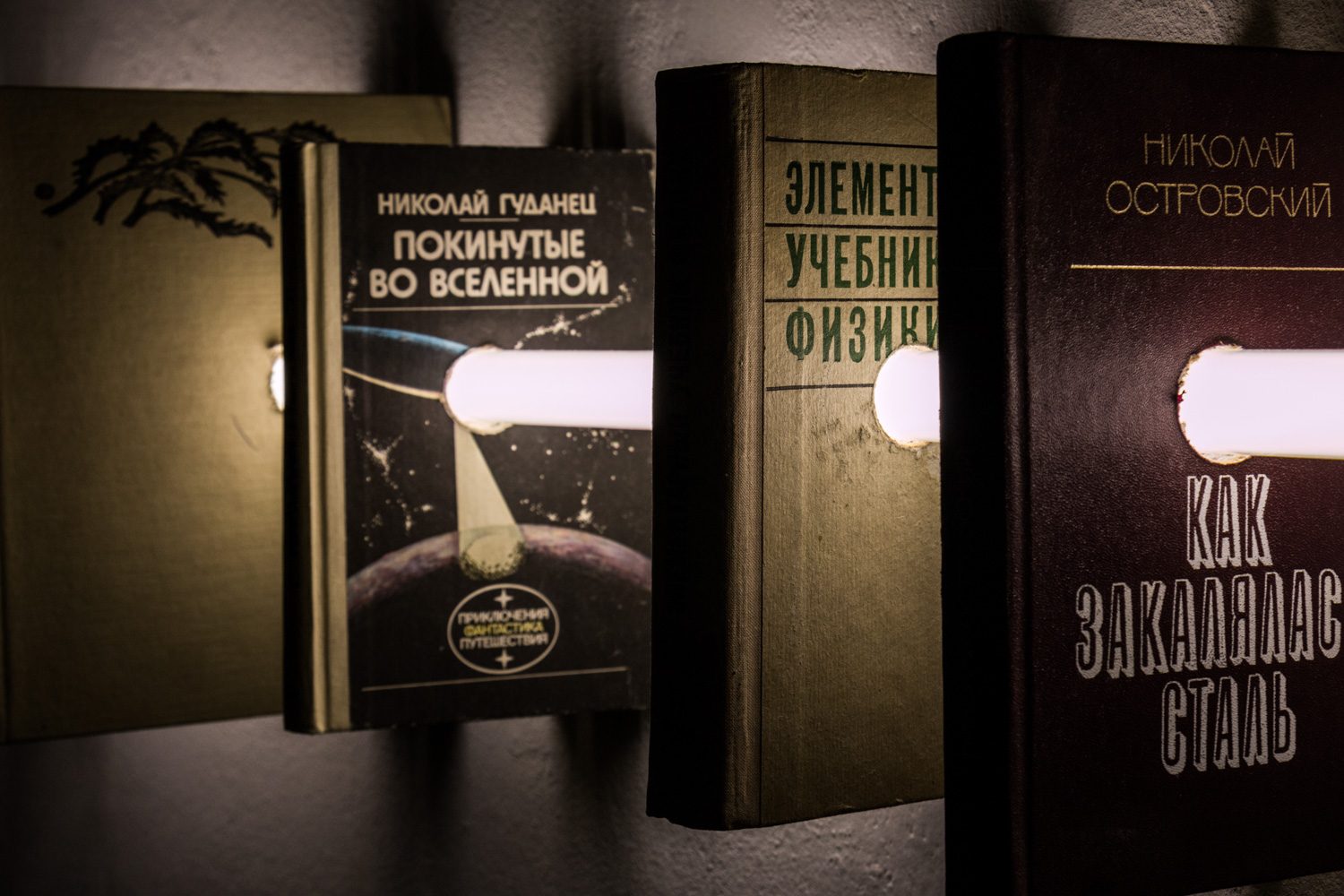
«From what source things arise, to that they have to return of necessity when they are destroyed for they suffer punishment and make reparation to one another for their injustice according to the assessment of time». —Anaximander
The transformative power of objects negotiating the liminal space between utilitarian practicality and aesthetic transcendence in the artistic context calls into question the nature of the object itself. Pushnitsky’s work navigates these boundaries and examines the contextualized meaning of our most familiar objects in the service of examining fundamental questions about the nature of object-hood and the limits of existence.
http://www.pushnitsky.ru/
Petr Shvetsov, Toilets Bacchanalia
Tiles painted with enamel, 2014
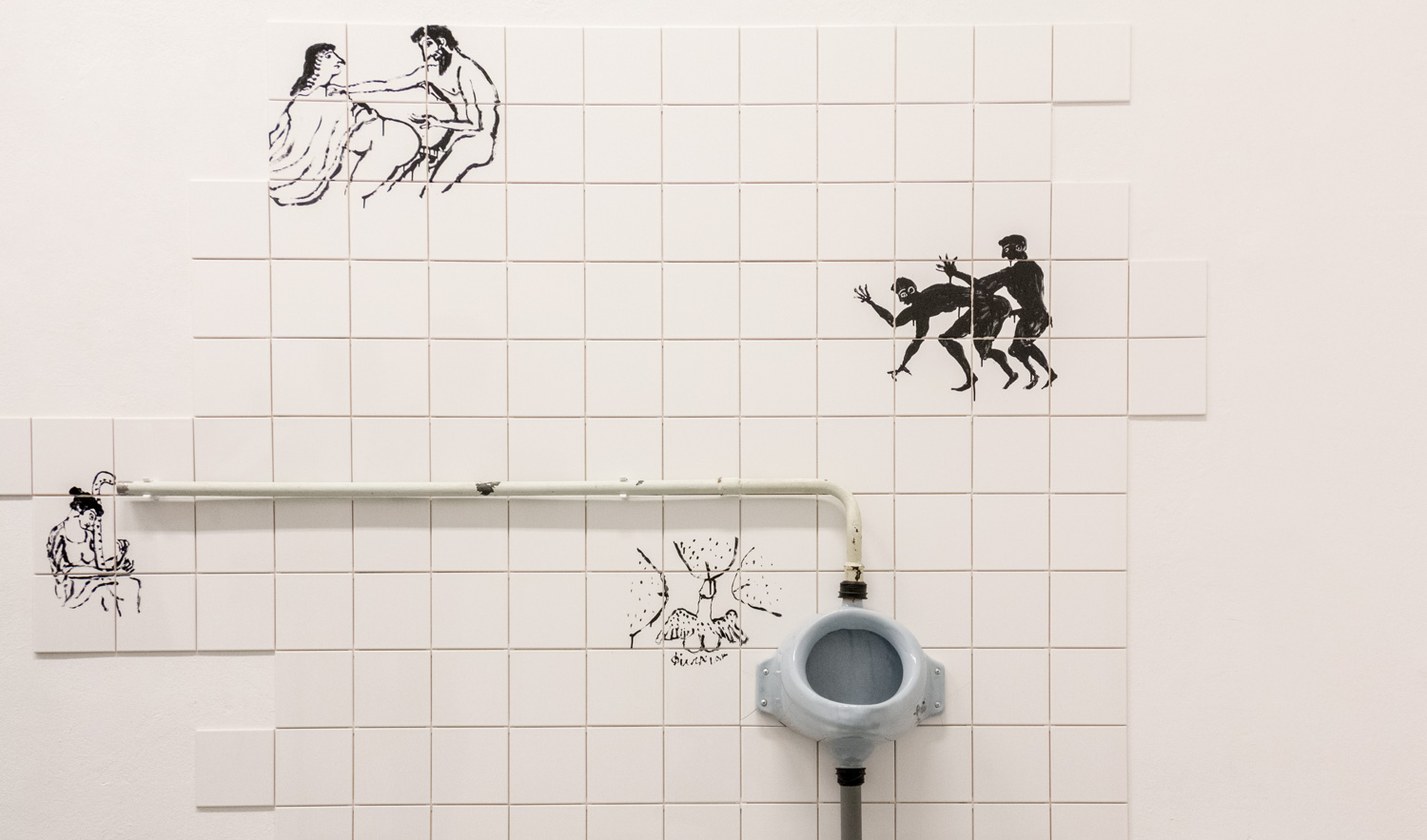
Petr Shvetsov reproduces erotic scenes from ancient vases and frescos onto the tiled walls of public toilets in the spirit of present day guerrilla graffiti. Shvetsov’s reproductions are sketches, live drawings infused with the vitality of the present moment rather than simple replicas of imagery produced millennia ago. By transporting imagery across time and space, these expressive, brutal and lively graphics endow the profane with the spirit of high art, maneuvering concepts of value to challenge our most deeply held beliefs about art and the erotic.
http://shvetsov.info/
Alexander Shishkin-Hokusai, Print Opera
Installation, 2013—2014
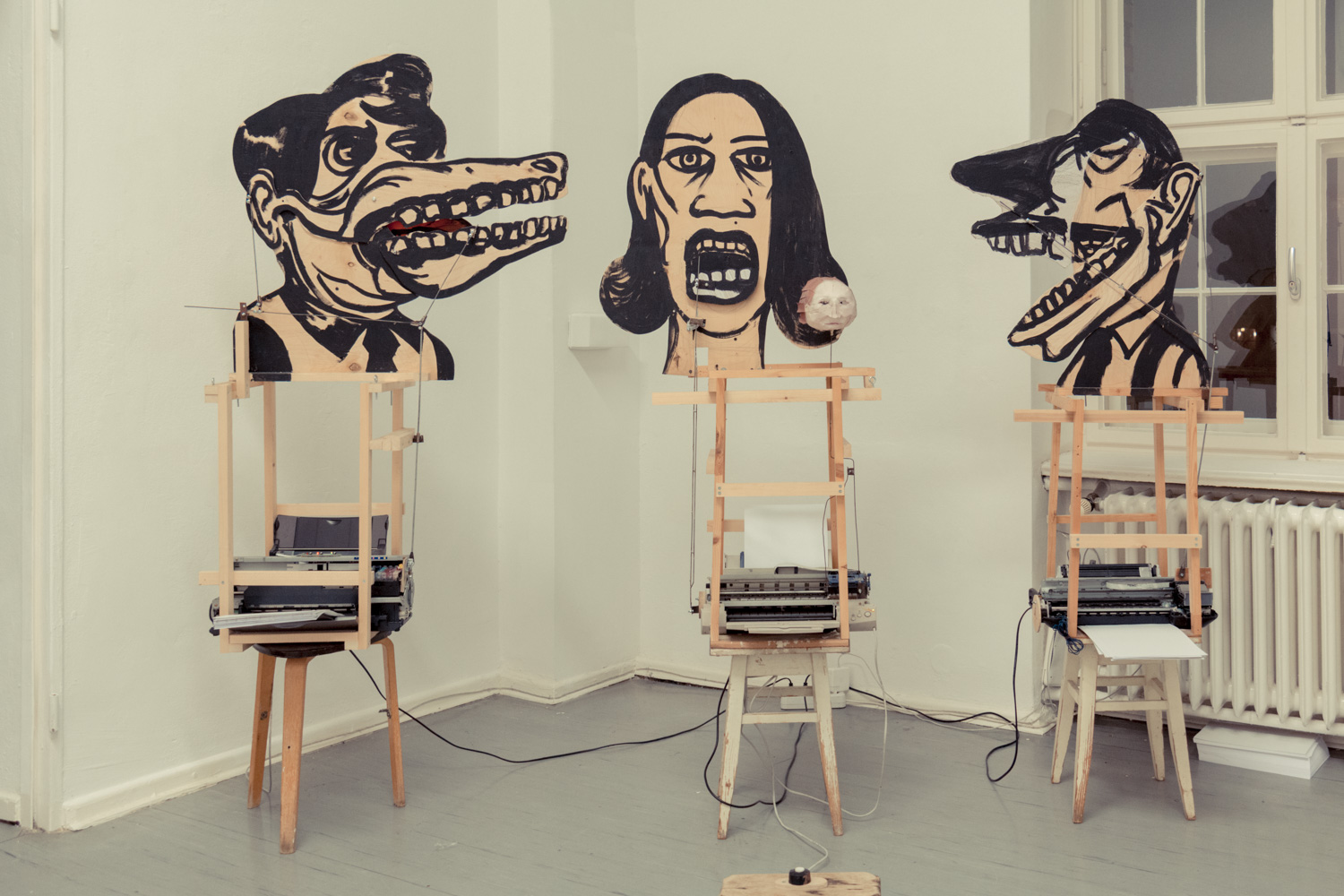
Throughout the 21st century, the number of hardware helpers accompanying us throughout our routine “life production” has grown such that the simple family home has come to closely resemble the factory floor, complete with ongoing hardware and software sequences dedicated to the constant production of activity considered necessary for a rich and full modern life.
With the introduction of hardware helpers to the home, a veritable cacophony of auditory and visual dynamics has descended upon private space—a theatrical performance of production moved onto the personal stage of the private home.
Drawing upon the work of Nam June Paik and John Cage, Shishkin-Hokusai’s work re-contextualizes the production behavior of everyday mechanical objects, highlighting the performative dynamic of hardware and reanimating our technologies in the process.
Alexander Terebenin, Last Portrait
Digital print on canvas, 2014
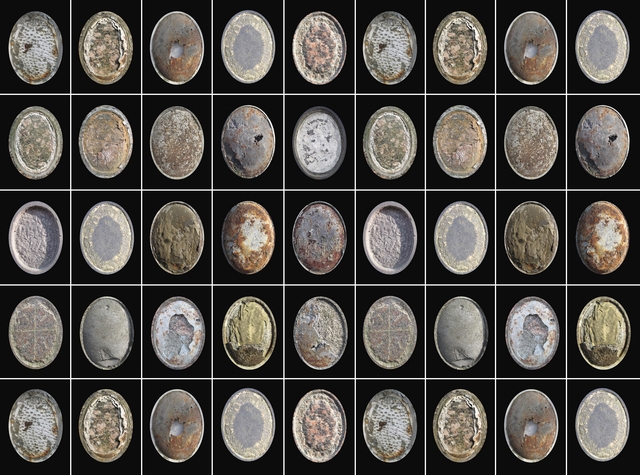
Peter Grunwald, a statistician at the Dutch Center of Mathematics and Computer Science, calculated that over 107 billion people were born on Earth throughout human history. If we are to trust those numbers and to factor in the 7 billion people currently living on the planet earth, then we can conclude that throughout time more than 100 billion people have been born and died on planet Earth.
Time whisked away the images of most of the former inhabitants of our planet, capturing only a a select few. At different times, the visual memory of the dead was preserved by way of death masks and funerary portraits in painting or in sculpture. With the advent of daguerreotype and photography itself, capturing an image for posterity became easier than ever, and by the twentieth century a culture of grave photo imagery emerged in force. This new form photography often manifests as enameled oval plaques at the site of the grave; however, these enamel images are not durable — these images fade in the sun, wash away in the rain, or simply disappear with time. As the years go, a new images replaces the lost photographs — an image created by the elements.
Billions of the departed didn’t leave their images behind. The Last Portrait is a monument to all mankind. —Alexander Terebenin